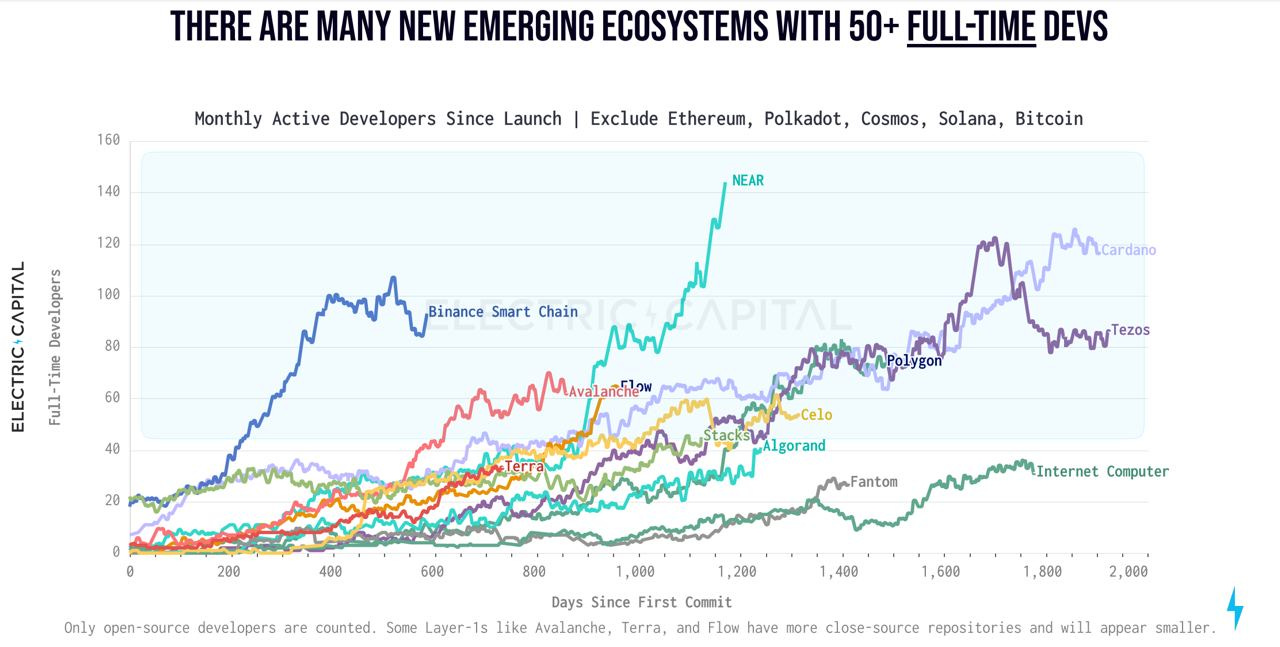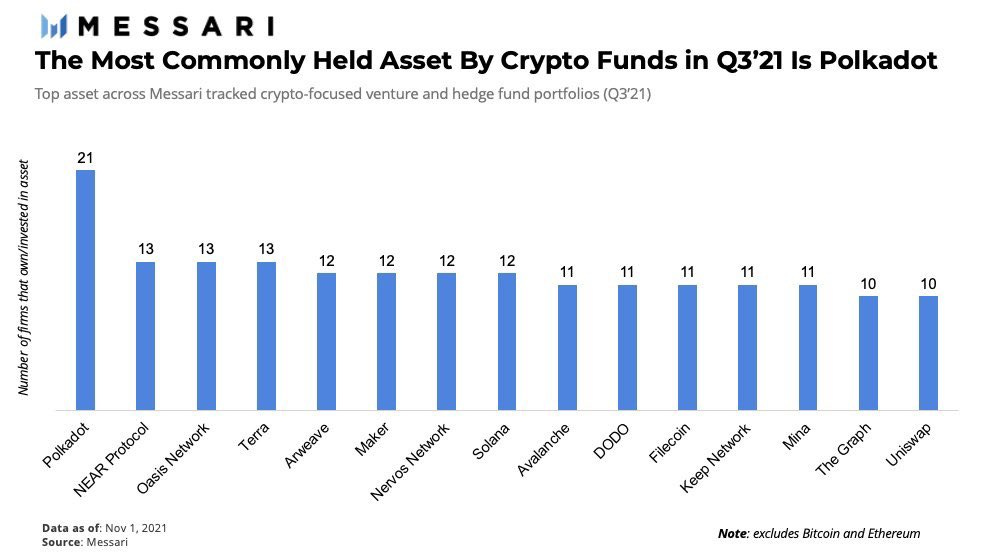The Future is NEAR.
An Investment Thesis
With scalable, high transaction throughput, rapid YoY developer increase, and several major upcoming catalysts: NEAR protocol is headed for all time highs.
General Overview
Near protocol is a development platform built on a sharded, proof-of-stake, layer-one blockchain designed for usability. It consists of a permissionless base layer, an independent native currency, a predetermined monetary policy, and a marketplace of computing resources. Near is the result of a huge, open source, decentralized collaboration effort by a team of 90+ world class developers and researchers with backgrounds from tech giants such as Google, Meta, Microsoft, and MemSQL.
Favoring pragmatism over perfection, Near’s underlying value proposition is that simplicity will ultimately drive adoption. Therefore, its measure of success is determined by the protocol’s ease of use and the ability for developers to build on Near as people who have never owned cryptocurrency before. Near is a developer-centric, layer-one blockchain platform that prioritizes both the developer and end user experience, which is why it will succeed in the long term.
Blockchain Architecture
At its core, Near is a community-operated cloud that acts as a marketplace of computing resources for participants. On the supply side there are validator node operators (currently 100 nodes) who are incentivized to secure the network. On the demand side there are developers and end-users who are the primary focus of the platform.
There is an inherent trilemma amongst layer-one protocols that acts as the biggest hurdle for adoption and success. The first is that users want security but are generally platform agnostic as long as there is a frictionless user experience. Secondly, developers care most about adoption which ensures the protocol will act as a sustainable source of long-term revenue for their applications. Moreover, validators want higher income for securing proof-of-stake networks. Lastly, users are also major token holders and want the native currency to act as a store of value over the long term.
The underlying solution to this trilemma is that as demand for tokens grows from new users and developers, application usage on the network will increase. Validators of the network then receive higher income since less tokens are staked, and more are burned which increases the validators’ yields. Through this economic flywheel, fees get lowered while still compensating validators so end users are happy as token holders, which results in improved security of the network.
NEAR vs. ETH 2.0
To paraphrase Naval Ravikant, “Near looks just like Ethereum 2.0’s roadmap except it is already implemented.” Ethereum 2.0’s goal is to be a sharded, proof-of-stake, layer-one EVM compatible blockchain that enables cheap, fast transactions while being both environmentally and developer friendly. The launch of Simple Nightshade kickstarted Near’s goal of being a fully sharded and secure blockchain.
Near utilizes a delegated proof-of-stake consensus mechanism that currently allows for 2500-3000 transactions per second. It consists of shards and validator seats (100 validators seats per shard) that grow linearly with network demand; therefore, lowering the barrier for entry and allowing for mass adoption in the future. The network optimizes for liveness over safety with Byzantine fault tolerance assumptions resulting in a sub 2 second finality for all transactions.
The biggest difference between Near and Ethereum 2.0 is that Near uses a single chain that shards each block instead of a beacon chain. This ensures data availability for consensus while mitigating shard level attacks. Dynamic re-sharding is expected to go live at the end of 2022, which will allow the network to maintain low transaction fees while enabling higher throughput. Meanwhile, this approach is environmentally friendly: Near was certified carbon-neutral in February 2021 by South Pole.
Developer-Centric Protocol
However, the protocol’s strongest competitive advantage compared to alternative layer-one blockchains is its developer friendliness. Near prides itself as a developer-first protocol that focuses on the developer experience to encourage adoption and usage of the network. Developers can write applications in Rust or Assembly Script since nodes run Web Assembly; therefore, there is no need for developers to learn a new programming language in order to start developing on Near.
Additionally, Near also has its own layer-two protocol, Aurora, which is EVM compatible and allows current Ethereum developers to seamlessly run their applications on Near at a fraction of the cost. Aurora helps bridge adoption between Ethereum and Near with 1 second block times, 2 second finality, and for roughly $0.02 per transaction. This low barrier to entry has resulted in significant developer adoption over the last couple of years.
Analyzing Growth
According to data from Electric Capital, Near has one of the most full time active monthly developers of any alternative layer-one blockchain.
They have one of the fastest growing ecosystems with a 4x growth of total developers over the last 2 years. This high developer growth rate is a key indicator that adoption and usage of the protocol will continue into the near future.
Developer Incentives
Developers can pay for gas and transaction costs if they believe that the lifetime value from the user will exceed the cost of gas. This provides predictable pricing for budgeting end user expectations. 30% of transaction fees are also given to smart contracts (shared equally between all contracts used during a transaction) which provides a sustainable revenue source for smart contract development. With the announcement of an $800 million incentive fund, developers have yet another attractive reason to start building on Near.
There is a 95-97% drop off rate during onboarding for blockchain based apps and games. The protocol focuses on progressive security (high usability with low security into vice versa). Newly onboarded end users are given an easy user experience with intuitive account names that end in “.near”. Furthermore, Near’s delegated proof of stake consensus also allows users to participate in ecosystem security right within the native wallet app from their first interaction with the platform. This ease of use coupled with the low barrier to entry for developers provides a core advantage for Near’s long term adoption.
Near Future Catalysts
Near has several catalysts that makes it a fundamentally attractive investment. At the end of January, they closed another $350 million round of funding led by Tiger Global, which only adds to the stellar list of venture capital behemoths supporting the Near ecosystem. According to Messari, Near is the 3rd most commonly held asset by crypto funds as of Q3 2021.
Moreover, Near will be listed on Coinbase’s exchange in the next couple of months, which will help drive retail visibility like never before. This also paves the way for Near NFTs to be integrated into Coinbase’s upcoming NFT marketplace. Lastly, on April 20th, Near will announce the launch of their own native algorithmic stablecoin $USN in partnership with other well capitalized stablecoins. They will offer an extremely attractive ~20% APR, which will ignite DeFi capital rotation into the Near ecosystem, siphoning the total value locked from other alternative layer-one protocols.
This will lead to a comparison of Near to Terra ($LUNA) as the narrative for attractive stablecoin yields proliferates. Terra currently has a market capitalization of approximately $40 billion while Near sits at $10 billion. The catalysts above will strengthen Near’s fundamentals in both the short and long term and likely cause its market capitalization to appreciate by 100% at minimum over the next few months.





>Near looks just like Ethereum 2.0’s roadmap except it is already implemented.
>100 nodes, network optimizes for liveness over safety
100 nodes?